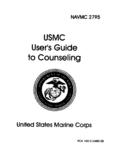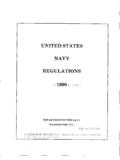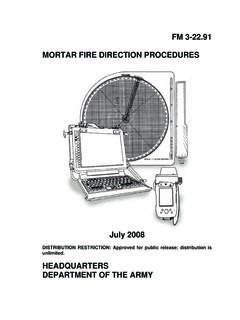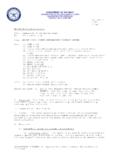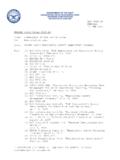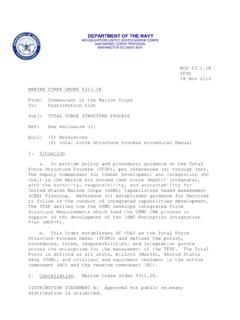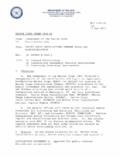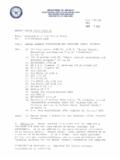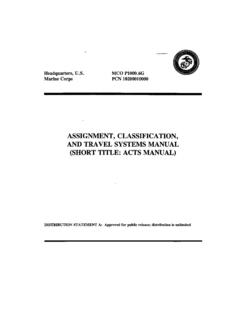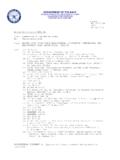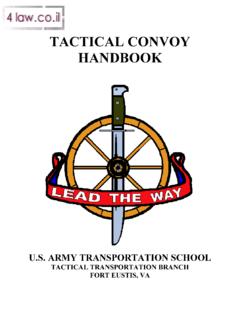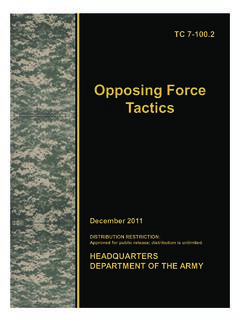Transcription of Military Operations on Urbanized Terrain (MOUT)
1 MCWP Military Operations on Urbanized Terrain (MOUT). Marine Corps PCN 143 000035 00. DEPARTMENT OF THE NAVY. Headquarters United States Marine Corps Washington, DC 20380-0001. FOREWORD 26 April 1998. 1. PURPOSE. Marine Corps Warfighting Publication (MCWP) , Military Operations on Urbanized Terrain (MOUT), provides doctrinal guidance and detailed information on tactics, techniques, and procedures to be employed in MOUT within the operating forces. 2. SCOPE. This manual provides guidance for the organization, planning, and conduct of the full range of Military Operations on Urbanized Terrain . This publication was prepared primarily for commanders, staffs, and subordinate leaders down to the squad and fire team level. It is written from a Marine air-ground task force perspective, with emphasis on the ground combat element as the most likely supported element in that environment.
2 It provides the level of detailed information that supports the complexities of planning, preparing for, and executing small-unit combat Operations on Urbanized Terrain . It also provides historical and environmental information that supports planning and training for combat in built-up areas. 3. SUPERSESSION. Operational Handbook (OH) 8-7, Military Operations on Urbanized Terrain (MOUT), dated November 1980. 4. CERTIFICATION. Reviewed and approved this date. BY DIRECTION OF THE COMMANDANT OF THE MARINE CORPS. RHODES. Lieutenant General, Marine Corps Commanding General Marine Corps Combat Development Command DISTRIBUTION: 143 000035 00. Military Operations on Urbanized Terrain Table of Contents Chapter 1. Modern Urban Warfare Page 1001. Importance of Urban Areas 1-1.
3 1002. The Marine Corps Role in Urban Warfare 1-1. 1003. Distinguishing Features of Urbanized Terrain 1-2. 1004. Modern Battles for Urbanized Terrain 1-8. 1005. Modern Urban Battle Analysis and Observations 1-12. 1006. Implications of Urban Warfare 1- 20. 1007. Key Insights 1-20. 1008. Necessity for Preparation 1-21. Chapter 2. Offense 2001. Introduction 2 -1. Section I. Planning 2-1. 2101 Considerations 2-1. 2102. Commander's Estimate 2-3. 2103. Phases of the Attack 2-8. 2104. Warfighting Functions 2-11. Section II. Infantry Battalion Operations 2-24. 2201. Overview 2-24. 2202. Seizure of a Key Objective 2-24. 2203. Infiltration 2-25. 2204. Route Security 2-28. 2205. Battalion Considerations 2-28. Section III. Rifle Company Operations 2-30. 2301. Overview 2-30. 2302 Attacking within a Built-up Area 2-30.
4 2303 Attack on an Enemy Outpost 2-32. 2304 Seizure of a Traffic Circle or Major Intersection 2-32. 2305 Seizure of Key Terrain 2-33. 2306 Movement to Contact 2-35. Section IV. Rifle Platoon Operations 2-37. 2401. Overview 2-37. 2402. Attack of a Building 2-37. 2403. Movement Down a Street 2-37. 2404. Utilization of the Reserve 2-38. Chapter 3. Defensive Operations 3001. Introduction 3-1. 3002 Decision to Defend 3-1. 3003 Reasons for Not Defending Built-Up Areas 3-2. iii Section I. Defensive Planning 3-3. 3101. Commander's Estimate 3-3. 3102. METT-T 3-3. 3103. Organizing for a Defense 3-9. 3104. Warfighting Functions 3-13. Section II. Infantry Battalion Defense of a Built-Up Area 3-26. 3201. Defense in Sector 3-26. 3202. Delay in a Built-Up Area 3-27. 3203. Defense of a Village 3-29.
5 Section III. Rifle Company Operations 3-31. 3301. Defense of a Village 3-31. 3302. Delay in a Built-Up Area 3-33. 3303. Defense Of a City Block 3-34. 3304. Defense of a Traffic Circle or Key Intersection 3-34. Section IV. Rifle Platoon Operations 3-36. 3401. Defense of a Strongpoint 3-36. 3402. Defense Against Armor 3-37. 3403. Conduct of Armored Ambush 3-40. Chapter 4. Combat Support 4001 Introduction 4-1. Section I. Fire Support 4-1. 4101. Indirect and Direct Fire Support 4-1. 4102. Artillery 4-2. 4103. Mortars 4-5. 4104. Naval Surface Fire Support and Naval Gunfire 4-7. 4105. Aviation 4-7. 4106. Armored Vehicles 4-9. 4107. Antiarmor Weapons 4-10. 4108. Employment of Snipers 4-10. Section II. Other Combat Support 4-13. 4201. Engineers 4-13. 4202. Assault Support Helicopters 4-15.
6 4203. Employment of Reconnaissance Forces 4-16. 4204. Military Police 4-17. 4205. Communications 4-17. 4206. Employment of Sensors 4-19. 4207 Employment of Air Defense 4-20. Chapter 5. Logistics and Combat Service Support 5101. Introduction 5- 1. 5102. Combat Service Support Resupply, Maintenance/Repair, and Replacement 5- 1. 5103. Critical Classes of Supply 5- 2. 5104. Health Service Support 5- 4. iv Chapter 6. Noncombatant Considerations in Urban Operations Section I. 6-1. 6101. Introduction 6-1. 6102. Noncombatant Impact 6-1. 6103 Command Authority 6-1. 6104. Source Utilization 6-2. 6105. Health and Welfare 6-2. 6106. Law and Order 6-2. 6107. Public Affairs Officer and Media Relations 6-2. 6108 Civil Affairs Activities and Psychological Operations 6-2. 6109 Refugee Control 6-3.
7 Section II. 6-5. 6201. Commander's Legal Authority and Responsibilities 6-5. Chapter 7. The Urban Environment and Restrictions to Operations Section I. Military Operations Other Than War 7-1. 7101. Introduction 7-1. 7102. Types of MOOTW 7-1. 7103. Recent Experiences and Lessons Learned 7-2. 7104. Urban Terrorism 7-3. Section II. Restrictive Conditions 7-5. 7201. Introduction 7-5. 7202. Rules of Engagement 7-5. 7203. Planning 7-6. Appendix A. Organization for Urban Combat and Fundamental Combat Skills Section I. Organization 1. Structure A-1. Section II. Weapons Handling and Firing Techniques 2. Weapons Carries A-3. 3. Firing Techniques A-5. Section III. Movement 4. Crossing a Wall A-7. 5. Observation Around Corners A-7. 6. Movement Past Windows A-8. 7. Use of Doorways A-9.
8 8. Movement Parallel to Buildings A- 10. 9. Crossing Open Areas A - 12. 10. Assault Element Employment A - 12. 11. Movement Inside a Building A - 13. Section IV. Entry Techniques 12. Upper Building Levels A - 16. 13. Use of Ladders A - 16. 14. Use of Grappling Hook A - 16. v 15. Scaling Walls A - 18. 16. Rappelling A - 19. 17. Entry at Lower Levels A - 19. 18. Hand Grenades A - 23. Section V. Clearing Techniques 19. Clearing a Room, Door Closed or Open, From Stacked Positions A - 27. 20. Clearing a Room, Door Closed, Split Positions A - 31. 21. Covering Team Members Used To Support Clearing of a Room A - 34. 22. Clearing a Room, Entering Through Mousehole A - 36. 23. Clearing an L-Shaped Hallway A - 36. 24. Clearing a T-Shaped Hallway A - 38. 25. Clearing a Stairwell A - 39.
9 Section VI. Firing Positions 26. Hasty Firing Position A - 41. 27. Prepared Firing Position A - 44. 28. Target Acquisition A - 51. 29. Firefighting Planning and Operations A - 54. 30. Employment of Snipers A - 55. Section VII. Advancing/Patrolling Along City Streets 31. Advancing/Patrolling Along City Streets A - 57. 32. Crossing a Street Intersection A - 61. 33. Reacting to Enemy Contact A - 65. Section VIII. Navigation in Built-Up Areas 34. Military Maps A - 67. 35. Aerial Photographs A - 68. Section IX. Camouflage 36. Application A - 69. 37. Use of Shadows A - 69. 38. Color and Texture A - 69. Appendix B. Employment and Effects of Weapons 1. Effectiveness of Weapons and Demolitions B-1. 2. M16 Rifle and M249 Squad Automatic Weapon B-2. 3. Medium/Heavy Machine Guns and Sniper Rifles ( mm and.)
10 50 caliber)B - 5. 4. Grenade Launchers, 40-mm (M203 and MK19) B-8. 5. Light and Medium Recoilless Weapons B - 10. 6. Antitank Guided Missiles B - 17. 7. Flame Weapons B - 22. 8. Hand Grenades B - 23. 9. 25-mm Automatic Gun B - 25. 10. Tank Cannon B - 28. 11. Artillery B - 32. 12. Mortars B - 35. 13. Naval Gunfire B - 37. 14. Aerial Weapons B - 37. vi 15. Demolitions B - 38. Appendix C. Attacking and Clearing Buildings 1. Introduction C-1. 2. Requirements C-1. 3. Fire Support C-1. 4. Movement C-3. 5. Assault C-3. 6. Clearing C-4. 7. Consolidation and Reorganization C - 11. Appendix D. Fighting Positions 1. Considerations D-1. 2. Preparation D-2. 3. Tank and Other Armored Vehicle Positions D - 10. 4. Antitank Guided Missile Positions D - 12. 5. Sniper Positions D - 12.
